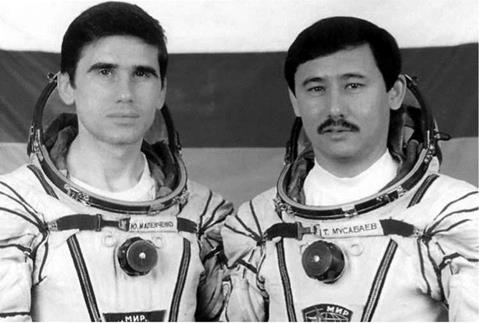. SOYUZ TM19
Flight Crew
MALENCHENKO, Yuri Ivanovich, 32, Russian Air Force, commander MUSABAYEV, Talgat Amangeldyevich, 43, Russian Air Force, flight engineer
Flight Log
The mission was delayed when the launch shroud designed to protect the spacecraft during its ascent through the atmosphere could not be delivered on time. By the end of June, the shroud had arrived and been installed on the vehicle in preparation for the launch. This was the first all-rookie crew since the Soyuz 25 mission in 1977, as mission planners finally began to have confidence both in the Kurs docking system and in the ability of the cosmonauts to take over manual control of the spacecraft if necessary to complete a docking approach. To align Russian operations with the proposed first American astronaut launch to Mir in March 1995, the EO-16 residency would be only for four months. Most of their first few weeks in space were spent in Earth observation photography, in particular of Kazakhstan around the Aral Sea region.
Confidence in the cosmonauts docking to Mir may have increased, but there were still problems in getting the Progress re-supply craft to link up successfully. On 27 August, the first automated docking of Progress M24 failed. Three days later, the craft bumped into Mir’s forward port before drifting away, hitting a solar array as it went by. With onboard supplies running low, the cosmonauts faced the prospect of abandoning Mir in late September and mothballing it for up to four months if they could not get a Progress to dock to the station. If this had been the case, it was hoped that another crew, and fresh supplies, would have been able to reach the station before its stabilisation propellant ran out. However, all this became academic when Malenchenko successfully used the TORU docking system aboard Mir to skilfully dock Progress M24 by remote control. The docking was critical to a number of events planned for the next Progress supply vehicle and if the station had had to be
|
Malenchenko (left) and Musabayev launched to Mir aboard Soyuz TM19 to operate the sixteenth residency aboard the station |
abandoned, Polyakov’s record space flight would have been curtailed. It was also fortunate that Malenchenko had docked M24, because it contained over 275 kg of ESA hardware in preparation for the Euro Mir 94 programme that Ulf Merbold would be running alongside the next resident crew. Without this docking, Merbold’s entire mission would have been in doubt.
The EO-16 crew completed two EVAs during their short stay on Mir. The first (9 Sep, 5 hours 6 minutes) focused on an inspection of the docking port hit by Progress M24 and the tear in the thermal blanket caused by the Soyuz TM17 incident. During the EVA, Polyakov monitored his two colleagues from within the space station. After replacing cassettes exposed to space on the outside of Kvant 2, the cosmonauts found that the damage caused by TM17, near to where Kristall joined the base block, was very light. They repaired the 30 cm x 40 cm gap in the thermal insulation blanket and subsequently found that Progress M24 had caused no serious damage to the transfer compartment of Mir. The second EVA (14 Sep, 6 hours 1 minute) was another inspection, this time of the movable arrays on Kristall, which were designed to be relocated on Kvant over a series of EVAs. They also looked at the mounting brackets and solar array drives on Kvant, which would house the arrays. Space exposure cassettes were removed from Rapana and the Sofora was inspected before a new amateur radio antenna was erected. Dr. Polyakov once again monitored EVA operations from inside the Mir, as he was not trained for EVA himself.
Milestones
170th manned space flight
78th Russian manned space flight
25th Russian and 54th flight with EVA operations
19th manned Mir mission
16th Mir resident crew
71st manned Soyuz mission
18th manned Soyuz TM mission











